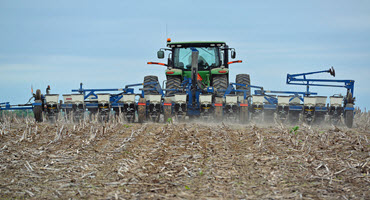Overall, 92 percent of the U.S. corn crop has been seeded
By Diego Flammini
Staff Writer
Farms.com
Producers in two Corn Belt states have wrapped up planting their 2018 corn crop.
Farmers in Missouri and Illinois are finished with corn planting, the USDA’s May 27 Weekly Weather and Crop Bulletin report says.
Overall, growers have planted 92 percent of the 2018 U.S. corn crop. That number is up from 81 percent last week.
Farmers in Indiana and Iowa, among others, have completed more than 90 percent of corn seeding for their respective states.
Growers in Pennsylvania have planted 59 percent of their corn crop, which is the lowest of the 18 documented states.
And almost three-quarters (72 percent) of the U.S. corn crop has emerged. That figure is up from 50 percent last week.
Corn in North Carolina is 94 percent emerged, which is the highest in the country. Corn in Pennsylvania is only 32 percent emerged, representing the lowest figure in the U.S.
The USDA ranked 63 percent of the national corn crop as good.
Soybeans
Producers have planted 77 percent of the national soybean crop. That figure represents a 21 percent increase from last week.
Louisiana soybean producers lead the U.S., having completed 96 percent of their planting.

Farmers in Michigan have planted 45 percent of their soybean crop. That number is the lowest of the 18 recorded states but does represent a 16 percent increase from last week’s report.
About 47 percent of U.S. soybeans have emerged, the USDA’s report says. That number is up from 21 percent last week.
Soybean crops in Louisiana are 92 percent emerged, which is the highest in the U.S. In contrast, only 16 percent of South Dakota’s soybeans have emerged.
Wheat
Around 73 percent of the winter wheat crop has headed. That figure is up from 61 percent last week, the USDA says.
All of the winter wheat in California and Arkansas has headed, while none of the crop in Montana has headed.
The USDA ranked 30 percent of the winter wheat crop as good.
Farmers are nearing completion of spring wheat planting.
The national total is 91 percent, which is up from 79 percent last week.
Growers in Washington have planted 97 percent of their spring wheat crop, which is the highest in the country.
About 63 percent of the spring wheat crop has emerged, the USDA says. That number is up from 37 percent last week.
Wheat in South Dakota is 90 percent emerged. That number is the highest of the six states documented.
Suitable fieldwork days
The states with the most suitable fieldwork days for the week ending May 27 were:
Arizona – 7
New Mexico and California – 6.8
Oregon – 6.7
During that week, the states with the fewest suitable fieldwork days were:
Georgia – 2.1
Delaware – 3
Maryland – 3.5
Weekly precipitation levels
State | Precipitation (inches) | Weather Station |
Illinois | 2.23 | Chicago/O’Hare |
Indiana | 0.12 | Evansville/Indianapolis |
Iowa | 1.75 | Cedar Rapids |
Kentucky | 0.95 | Lexington |
Michigan | 0.96 | Muskegon |
Missouri | 1.68 | Columbia |
New York | 1.18 | Buffalo |
Pennsylvania | 2.11 | Williamsport |
Tennessee | 2.43 | Bristol |
The next Weekly Weather and Crop Bulletin will be released on Tues., June 5.